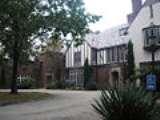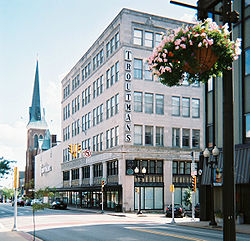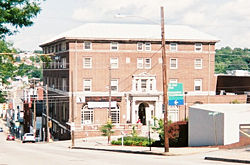
Paul Bartholomew
Encyclopedia
Paul Amos Batholomew was an architect in Greensburg, Pennsylvania
. From the beginning of his practice, he received a variety of high-profile commissions for both residential and non-residential structures, mainly in Westmoreland County, Pennsylvania
. His buildings typically had historicist
facades, with neoclassical
or Italianate
ornamentation covering a modern framework. It was only in the 1950s, toward the end of his career, that he created buildings that were purely modern in design. During the Great Depression
, a particularly trying time for architects, he received the commission to design Norvelt
, which was a new town created as part of President Roosevelt's
New Deal
policies.
One of his commissions, the Citizens National Bank of Latrobe, Pennsylvania
, designed with partner Brandon Smith, is listed on the National Register of Historic Places
. Many of Bartholomew's works are contributing properties to the Greensburg Downtown Historic District and the Academy Hill Historic District.
on June 25, 1883. His parents were the Rev. Amos H. Bartholomew, a Lutheran minister, and Rachael (Kuhns) Bartholomew. Most of Paul Bartholomew's childhood was spent in Ligonier, Pennsylvania
. He graduated from Gettysburg College
in 1905, and then studied architecture at the University of Pennsylvania
, from which he received a second degree in 1908. After graduation, he worked under architects in Philadelphia and Pittsburgh.
He eventually settled in Greensburg where he began his practice. Sources differ on the date he began his Greensburg practice; one source claims 1910 although his entry in an architects' directory states he began his practice in 1912. Throughout most of his career, his office was in the Coulter Building at 231 South Main Street in Greensburg. However, two 1929 publications list an office in the Keenan Building, Pittsburgh.
Paul Bartholomew married Dorothy W. Lyon, a Greensburg resident, on November 1, 1916. Paul Bartholomew died on December 8, 1973, at the age of 90.


 Among Bartholomew's commissions were the following:
Among Bartholomew's commissions were the following:
The remaining items are in chronological order:
Greensburg, Pennsylvania
Greensburg is a city in Westmoreland County, Pennsylvania, United States, and a part of the Pittsburgh Metro Area. The city is named after Nathanael Greene, a major general of the Continental Army in the American Revolutionary War...
. From the beginning of his practice, he received a variety of high-profile commissions for both residential and non-residential structures, mainly in Westmoreland County, Pennsylvania
Westmoreland County, Pennsylvania
-Demographics:As of the census of 2000, there were 369,993 people, 149,813 households, and 104,569 families residing in the county. The population density was 361 people per square mile . There were 161,058 housing units at an average density of 157 per square mile...
. His buildings typically had historicist
Historicism (art)
Historicism refers to artistic styles that draw their inspiration from copying historic styles or artisans. After neo-classicism, which could itself be considered a historicist movement, the 19th century saw a new historicist phase marked by a return to a more ancient classicism, in particular in...
facades, with neoclassical
Neoclassical architecture
Neoclassical architecture was an architectural style produced by the neoclassical movement that began in the mid-18th century, manifested both in its details as a reaction against the Rococo style of naturalistic ornament, and in its architectural formulas as an outgrowth of some classicizing...
or Italianate
Italianate architecture
The Italianate style of architecture was a distinct 19th-century phase in the history of Classical architecture. In the Italianate style, the models and architectural vocabulary of 16th-century Italian Renaissance architecture, which had served as inspiration for both Palladianism and...
ornamentation covering a modern framework. It was only in the 1950s, toward the end of his career, that he created buildings that were purely modern in design. During the Great Depression
Great Depression
The Great Depression was a severe worldwide economic depression in the decade preceding World War II. The timing of the Great Depression varied across nations, but in most countries it started in about 1929 and lasted until the late 1930s or early 1940s...
, a particularly trying time for architects, he received the commission to design Norvelt
Norvelt, Pennsylvania
Norvelt is an unincorporated community in Mount Pleasant Township, Westmoreland County, Pennsylvania, United States. Although the United States Census Bureau includes it in a census-designated place with the nearby community of Calumet, they are in reality two very different communities, each...
, which was a new town created as part of President Roosevelt's
Franklin D. Roosevelt
Franklin Delano Roosevelt , also known by his initials, FDR, was the 32nd President of the United States and a central figure in world events during the mid-20th century, leading the United States during a time of worldwide economic crisis and world war...
New Deal
New Deal
The New Deal was a series of economic programs implemented in the United States between 1933 and 1936. They were passed by the U.S. Congress during the first term of President Franklin D. Roosevelt. The programs were Roosevelt's responses to the Great Depression, and focused on what historians call...
policies.
One of his commissions, the Citizens National Bank of Latrobe, Pennsylvania
Latrobe, Pennsylvania
Latrobe is a city in Westmoreland County, Pennsylvania in the United States, approximately southeast of Pittsburgh.The city population was 7,634 as of the 2000 census . It is located near the Pennsylvania's scenic Chestnut Ridge. Latrobe was incorporated as a borough in 1854, and as a city in 1999...
, designed with partner Brandon Smith, is listed on the National Register of Historic Places
National Register of Historic Places
The National Register of Historic Places is the United States government's official list of districts, sites, buildings, structures, and objects deemed worthy of preservation...
. Many of Bartholomew's works are contributing properties to the Greensburg Downtown Historic District and the Academy Hill Historic District.
Biography
Paul Batholomew was born in Cleveland, OhioCleveland, Ohio
Cleveland is a city in the U.S. state of Ohio and is the county seat of Cuyahoga County, the most populous county in the state. The city is located in northeastern Ohio on the southern shore of Lake Erie, approximately west of the Pennsylvania border...
on June 25, 1883. His parents were the Rev. Amos H. Bartholomew, a Lutheran minister, and Rachael (Kuhns) Bartholomew. Most of Paul Bartholomew's childhood was spent in Ligonier, Pennsylvania
Ligonier, Pennsylvania
Ligonier is a borough in Westmoreland County, Pennsylvania, United States. The population was 1,695 at the 2000 census. Ligonier was settled in the 1760s. The borough is well known for nearby Idlewild Park, one of the oldest amusement parks in the country, and nearby Seven Springs Mountain Resort...
. He graduated from Gettysburg College
Gettysburg College
Gettysburg College is a private four-year liberal arts college founded in 1832, in Gettysburg, Pennsylvania, United States, adjacent to the famous battlefield. Its athletic teams are nicknamed the Bullets. Gettysburg College has about 2,700 students, with roughly equal numbers of men and women...
in 1905, and then studied architecture at the University of Pennsylvania
University of Pennsylvania
The University of Pennsylvania is a private, Ivy League university located in Philadelphia, Pennsylvania, United States. Penn is the fourth-oldest institution of higher education in the United States,Penn is the fourth-oldest using the founding dates claimed by each institution...
, from which he received a second degree in 1908. After graduation, he worked under architects in Philadelphia and Pittsburgh.
He eventually settled in Greensburg where he began his practice. Sources differ on the date he began his Greensburg practice; one source claims 1910 although his entry in an architects' directory states he began his practice in 1912. Throughout most of his career, his office was in the Coulter Building at 231 South Main Street in Greensburg. However, two 1929 publications list an office in the Keenan Building, Pittsburgh.
Paul Bartholomew married Dorothy W. Lyon, a Greensburg resident, on November 1, 1916. Paul Bartholomew died on December 8, 1973, at the age of 90.
Partnership with Smith
Bartholomew formed a partnership with Brandon Smith (1889–1962), although sources differ on the year the partnership began. One source claims the partnership commenced in 1915, while Bartholomew's entry in an architects' directory states it began in 1920. In any event, the firm of Bartholomew & Smith was dissolved in 1928 when Smith left to form his own firm, Smith & Reif.Notable commissions



- Houses in Academy Hill, Greensburg: The Academy Hill Historic District was created by the National Park ServiceNational Park ServiceThe National Park Service is the U.S. federal agency that manages all national parks, many national monuments, and other conservation and historical properties with various title designations...
, in part, to recognize the houses Bartholomew designed in this traditionally elite neighborhood. (Year of construction is in parentheses.) On North Main Street, he designed numbers 419 (1935), 431 (1920), 445 (1913), and 450 (1920). On North Maple Avenue, he designed numbers 528 (1913) and 552 (1922). On Walnut Avenue, he designed number 334 (1936). On Kenneth Street, he designed numbers 208 (1920) & 214 (1937). 208 Was his residence from 1920 until his death in 1973.
The remaining items are in chronological order:
- Greensburg YMCAYMCAThe Young Men's Christian Association is a worldwide organization of more than 45 million members from 125 national federations affiliated through the World Alliance of YMCAs...
(1912): Located at 101 South Maple Avenue (corner of East Pittsburgh Street), in Greensburg, Pennsylvania, this 1912 structure is a four-story red brick building with Classical elements. This was Bartholomew's first major non-residential commission. The third and fourth floors consisted of rooms that could be rented, and that part of the building became a residence for elderly men of limited means. The second floor had meeting rooms, and the main floor had a lobby, gym, and residents' lounge. The basement had a swimming pool, weight room, and locker rooms. There was a sub-basement for mechanical equipment. Over the years, the building has undergone major renovations. Nonetheless, the exterior has hardly changed, except for a 1969 addition on the south side of the building to house a new pool.
- Troutman's Department Store (1923): Located in Greensburg, this is a six-story Italianate structure with a limestone and terracotta facade built in 1923. The building still stands at 202-226 South Main Street. Although the interior has been gutted and converted into offices and seniors' housing, the exterior remains unchanged and in excellent condition.
- Lynch Hall (1923): This Tudor-style mansion was built in 1923 for Charles McKenna Lynch (1884–1963), an executive of the H.C. Frick Coke Company. The house's original name was Starboard Light, in reference to Lynch's earlier career as a naval officer. Its current street address is 150 Finoli Drive, Greensburg, Pennsylvania (actually located in Hempfield TownshipHempfield Township, Westmoreland County, PennsylvaniaHempfield Township is a township in Westmoreland County, Pennsylvania, United States. The population was 43,241 at the 2010 census, making it the largest suburb in the Pittsburgh Metropolitan Area by population.- Geography :...
), where it serves as the administrative building for University of Pittsburgh at GreensburgUniversity of Pittsburgh at GreensburgUniversity of Pittsburgh at Greensburg, commonly referred to as Pitt-Greensburg or UPG, is a four-year, baccalaureate degree-granting, regional residential campus of the University of Pittsburgh located in Hempfield Township, Westmoreland County, Pennsylvania. Opened in 1963, UPG was granted...
.
- First Commonwealth Bank (1924): Originally known as First National Bank and later as Southwest Bank, this seven-story red brick building is in a Classical Revival style, built in 1924 at 111 South Main Street, Greensburg. The firm of Bartholomew & Smith were the architects.
- Citizens National Bank (1926): This is in nearby LatrobeLatrobe, PennsylvaniaLatrobe is a city in Westmoreland County, Pennsylvania in the United States, approximately southeast of Pittsburgh.The city population was 7,634 as of the 2000 census . It is located near the Pennsylvania's scenic Chestnut Ridge. Latrobe was incorporated as a borough in 1854, and as a city in 1999...
, where it is the tallest building of that city. It is located at 816 Ligonier Street (corner of Main Street) in Latrobe. This six story, Classical Revival structure has a bank on the ground floor and offices on upper floors. It was later known as the Mellon Bank Building. The architects were the firm of Bartholomew & Smith, and the building is listed in the National Register of Historic PlacesNational Register of Historic PlacesThe National Register of Historic Places is the United States government's official list of districts, sites, buildings, structures, and objects deemed worthy of preservation...
.
- Fort Jackson Hotel (1926): This three-story, red brick structure at 19 South Washington Street in Waynesburg, PennsylvaniaWaynesburg, PennsylvaniaWaynesburg is a borough in and the county seat of Greene County, Pennsylvania, United States, southwest of Pittsburgh. The population was 4,184 at the 2000 census....
was designed by the firm of Bartholomew & Smith. It was originally a hotel and was later converted into offices.
- Beta Theta PiBeta Theta PiBeta Theta Pi , often just called Beta, is a social collegiate fraternity that was founded in 1839 at Miami University in Oxford, Ohio, USA, where it is part of the Miami Triad which includes Phi Delta Theta and Sigma Chi. It has over 138 active chapters and colonies in the United States and Canada...
Fraternity House (1929): This 1929 building is still in use as a fraternity house at 220 North Burrowes Street, State College, PennsylvaniaState College, PennsylvaniaState College is the largest borough in Centre County in the U.S. state of Pennsylvania. It is the principal city of the State College, Pennsylvania Metropolitan Statistical Area which encompasses all of Centre County. As of the 2010 census, the borough population was 42,034, and roughly double...
.
- Community of Norvelt, PennsylvaniaNorvelt, PennsylvaniaNorvelt is an unincorporated community in Mount Pleasant Township, Westmoreland County, Pennsylvania, United States. Although the United States Census Bureau includes it in a census-designated place with the nearby community of Calumet, they are in reality two very different communities, each...
, originally Westmoreland Homesteads (1934–1937): This planned community in Mount Pleasant Township, Westmoreland County, PennsylvaniaMount Pleasant Township, Westmoreland County, PennsylvaniaMount Pleasant Township is a township in Westmoreland County, Pennsylvania, in the United States. As of the 2000 census, the township population was 11,153...
, was built by the federal government during the Great DepressionGreat DepressionThe Great Depression was a severe worldwide economic depression in the decade preceding World War II. The timing of the Great Depression varied across nations, but in most countries it started in about 1929 and lasted until the late 1930s or early 1940s...
as one of 92 "subsistence homesteads" intended to address rural poverty. Paul Bartholomew received the commission to lay out the plan of streets, which he did in a nontraditional pattern of circles and semicircles. The layout was quite spacious with large lots, and it was intended that laid-off mine workers would be able to raise their own food. He also designed over 200 Cape Cod style houses for the community, as well as its public buildings. Land acquisition began in 1934, and the formal dedication, attended by Eleanor RooseveltEleanor RooseveltAnna Eleanor Roosevelt was the First Lady of the United States from 1933 to 1945. She supported the New Deal policies of her husband, distant cousin Franklin Delano Roosevelt, and became an advocate for civil rights. After her husband's death in 1945, Roosevelt continued to be an international...
, was held on May 21, 1937. The community's name was changed from Westmoreland Homesteads to Norvelt in her honor. Although the individual buildings have been remodeled over the intervening years, a visitor can still gain a good sense of what the community was like when it opened.
- Zions Lutheran Church (Renovations) (1937 and 1951): This church is located at 146 South Pennsylvania Avenue (at West Second Street), Greensburg, Pennsylvania. The current structure dates from 1877, although Paul Bartholomew was responsible for renovations in 1937 and 1951. His father had once been pastor of this church.
- Laufe House (1953): This was built at 949 Summit Drive in Greensburg, Pennsylvania, for Mr. and Mrs. Joseph H. Laufe. Paul Bartholomew was listed as the architect and Herbert Walfish, later a partner of Bartholomew, was listed as "designer." This is a very rare example of modern architecture of Paul Bartholomew, who almost always preferred facades with a historical flavor. This two-bedroom house is one story with basement, and has large windows across the back. The exterior consists of redwood and brick, and many interior walls consist of brick and polished wood.
- Excela Westmoreland Hospital Addition (1953): Originally Westmoreland Hospital, the street address is 532 West Pittsburgh Street, Greensburg, Pennsylvania. This complex is a hodgepodge of various additions; Paul Bartholomew was responsible for the 1953 component of this building, with James H. Ritchie and Associates of Boston as associate architects.
See also
- Academy Hill Historic District
- Greensburg Downtown Historic District
- Greensburg, PennsylvaniaGreensburg, PennsylvaniaGreensburg is a city in Westmoreland County, Pennsylvania, United States, and a part of the Pittsburgh Metro Area. The city is named after Nathanael Greene, a major general of the Continental Army in the American Revolutionary War...
- Norvelt, PennsylvaniaNorvelt, PennsylvaniaNorvelt is an unincorporated community in Mount Pleasant Township, Westmoreland County, Pennsylvania, United States. Although the United States Census Bureau includes it in a census-designated place with the nearby community of Calumet, they are in reality two very different communities, each...

